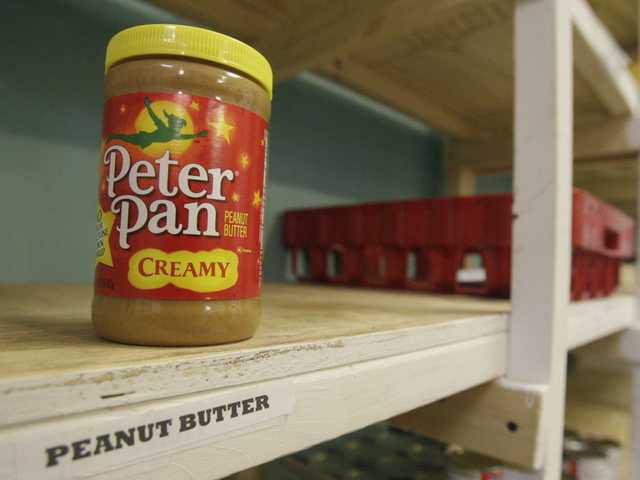ATLANTA — Consumers should be prepared to shell out a bit more for peanut butter soon.
Another hot, dry summer in key producing states and competition from more profitable crops like cotton have significantly shrunk the U.S. peanut crop this year. The tight supply means consumers will soon pay more for yet another grocery staple.
U.S. farmers are expected to produce roughly 1.8 million tons of peanuts this year, down nearly 13 percent from last year, according to a survey released Wednesday by the Department of Agriculture. Assuming that estimate holds, it would be smallest harvest recorded since 2006.
Peanut butter producers already have plans to hike prices for peanut butter significantly in the next few weeks. Those who package nuts for snacks say they are watching their competitors to determine whether price hikes will be necessary.
The J.M. Smucker Co., which makes Jif peanut butter, plans to raise its wholesale prices 30 percent in November. Kraft Foods Co., which launched its Planters peanut butter in June, is raising prices 40 percent on Oct. 31. A spokesperson for ConAgra Foods Inc., which makes Peter Pan peanut butter, was not immediately available to comment but multiple media outlets report that the company plans to raise its prices as well.
Unilever, which makes Skippy brand peanut butter, would not comment specifically on its pricing but said that the company is watching the commodities market very closely and will make pricing adjustments as needed.
"It's been a tough season, it sure has," said Rodney Dawson, a farmer in Hawkinsville, Ga.
Like many farmers, Dawson found at the start of the planting season that he could make more money growing corn and cotton than peanuts. As a result, he and other U.S. growers cut back on planting peanuts.
A miserable drought and scorching temperatures followed in key peanut-producing states like Georgia and Texas. For some farmers this was the second hot summer in a row.
Peanut farmers had to delay planting this spring because of the heat, which cut their production. Others saw the plants they'd put in the ground scorch during the summer when the shoots, which poke back into the ground to produce the peanut seed, burned as they touched the hot soil.
Georgia, the largest peanut-producing state in the country, saw record-breaking heat and a lack of rainfall that prevented some peanut seeds from even germinating in the field. Other plants that did grow were baked in the hot summer sun, producing poor-quality nuts or sometimes nothing at all.
Dawson was able to irrigate his farm to produce peanuts. In the dry corners where water didn't reach, however, he said his crop yielded about a quarter of his irrigated areas. And his profits were eroded by the cost of burning pricey fuel to run the irrigation system.
In a mean twist of irony, Dawson and his neighbor, farmer David Bishop, finally got rain as they were harvesting. Bishop said that on some of his land, he expects to get as little as a third of the maximum 3,000 pounds of peanuts per acre he would expect in a good year. The vast majority of his 300 acres of peanuts are planted on land without an irrigation system.
"It's too little, too late," Bishop said. "We needed this rain back in July and August."
A farmer for three decades, Bishop said he had never seen a drought that arrived as early as this year's. It took about three weeks to get his plants out of the ground, three times as long as normal.
"It was so dry you didn't have any moisture in the soil to make the seed even rot," he said. "It just laid there in the soil. I've never seen that before."
Farmers typically sell their crop to shellers and negotiate those pricing contracts ahead of time, allowing them to decide how much crop to plant.
But according to USDA estimates this week, farmers who had runner peanuts — the most common kind and the type used for peanut butter — could sell their crop for nearly $1,200 a ton, up from nearly $450 a ton last year.
While it's a devastating season for farmers, it's tough on consumers too as they've seen a run-up in the cost of groceries from coffee to cereal on higher commodity costs over the past year.
Peanut butter is considered a staple many U.S. diets. U.S. consumers eat about 6 pounds of peanut products a year, according to the American Peanut Council, an industry trade group. It estimates the market is worth more than $2 billion at the retail level and the bulk of that is in peanut butter sales.
"We probably won't be happy about it but we will still buy it," said Sarah Creem, a mother of two in Portland, Ore. whose family goes through a container of peanut butter every few weeks. "As picky as children are with food, you will buy what they eat."
Some peanut manufacturers have told supermarkets they will pare back peanut-based product lines and could increase prices next month, said Tracy Pawelski, a spokeswoman for Ahold USA, the parent company of the Stop and Shop, Giant and Martin's grocery stores. The ingredient costs for the grocery chain's store-brand peanut butter have increased 30 to 50 percent, depending on the supplier.
The firm said it will work with its suppliers to mitigate price increases, but it expects supply problems will linger until next year's harvest.
"Customers will continue to see increases in prices at the shelf," Pawelski said.
Are you ready to pay more for peanut butter?
Costs are expected to rise because of peanut shortage


Sign up for the Herald's free e-newsletter